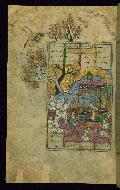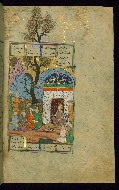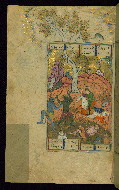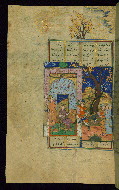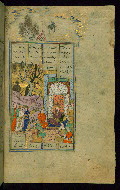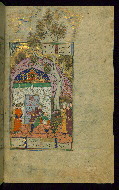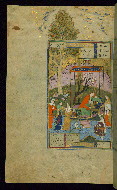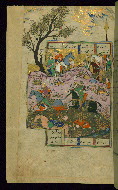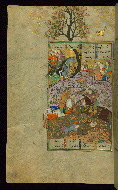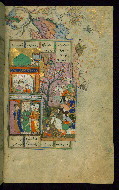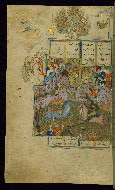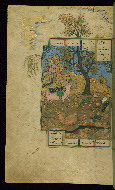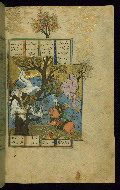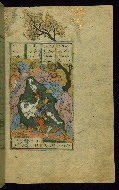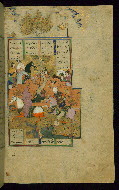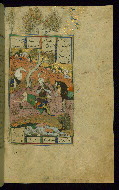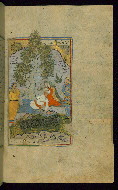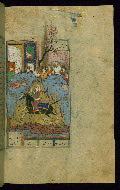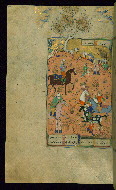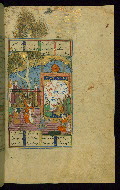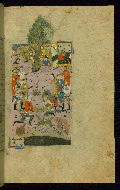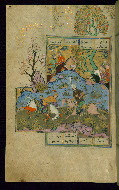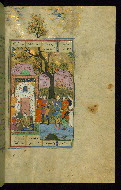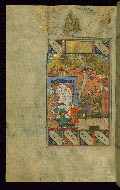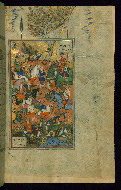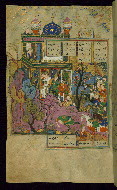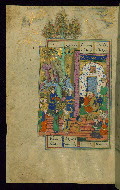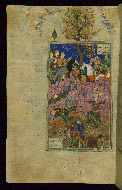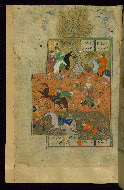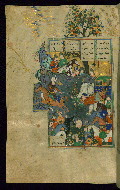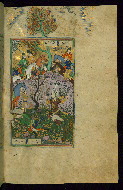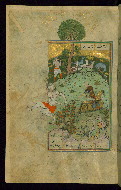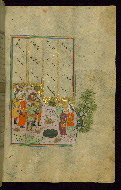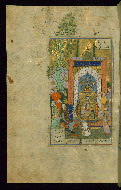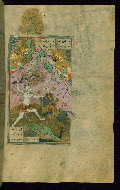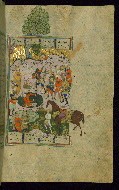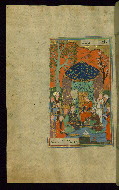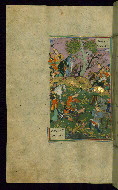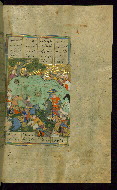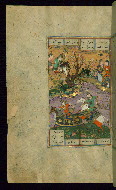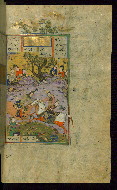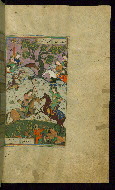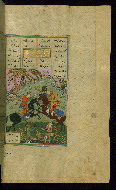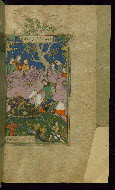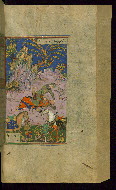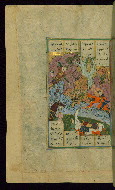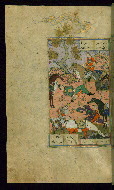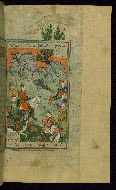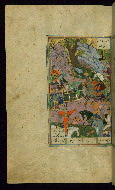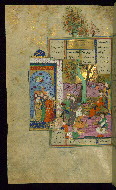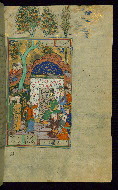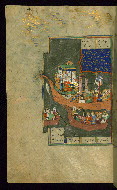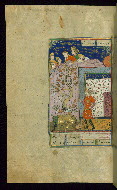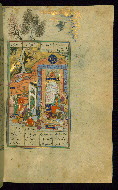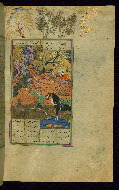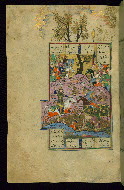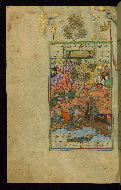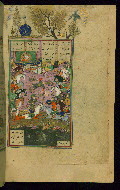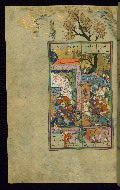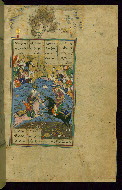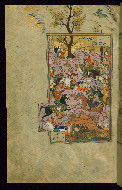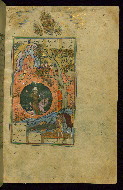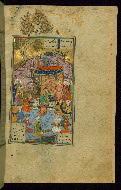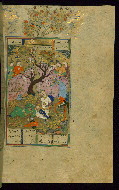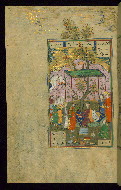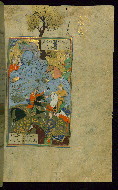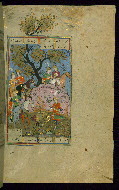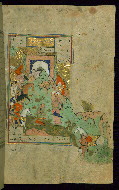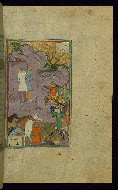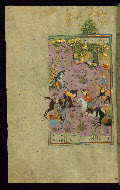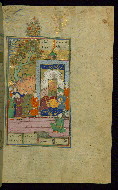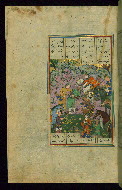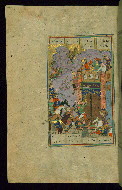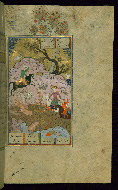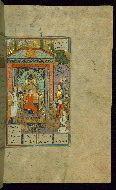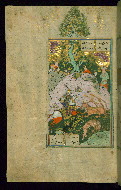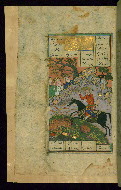Home > Digitized Walters Manuscripts
This document is a tranformation of a TEI P5 XML manuscript description incorporating images. If you have trouble reading special or non-Latin characters on this page, please make sure you have appropriate Unicode fonts installed and an up-to-date web browser.
Walters Ms. W.602, Book of kings (Shahnama)
Browse images (Browse images in a new window) | TEI in XML format
W.602
Book of kings (Shahnama)
Vernacular: شاهنامه
Authority name: Firdawsī
As-written name: Abū al-Qāsim Ḥasan ibn Isḥāq Firdawsī Ṭūsī
Name, in vernacular: ابو القاسم حسن بن اسحاق فردوسى طوسى
Note: Author dates preferred by cataloger: d. 411 or 416 AH / 1020-5 CE
This copy of Firdawsī's Shāhnāmah (Book of kings) was written by Muḥammad Mīrak ibn Mīr Muḥammad al-Ḥusaynī al-Ustādī, most probably in Herat (present-day Afghanistan). It was completed in 1028 AH / 1618-9 CE. There are two Arabic colophons, one at the end of the preface (fol. 7a) and the other at the end of part 1 (fol. 334a). The preface is by Abū Manṣūr Muḥammad ibn ʿAbd al-Razzāq, who composed it in 346 AH / 957-8 CE. Although incomplete at the end, the manuscript contains eighty-three illustrations. Some are by a later hand and attributed to Safavid artists Rizā ʿAbbāsī and Shaykh ʿAbbāsī in the eleventh century AH / seventeenth CE (fols. 55b, 62b, 391b, 476b, and 479b). The lacquer binding is not contemporary with the manuscript and dates to the thirteenth century AH / nineteenth CE.
1028 AH / 1618-9 CE (fol. 7a, end of preface); 1027 AH / 1617-8 CE (fol. 334a, end of part 1)
Probably Herat (present-day Afghanistan)
As-written name: Muḥammad Mīrak ibn Mīr Muḥammad al-Ḥusaynī al-Ustādī
Name, in vernacular: محمد ميرك بن مير محمد الحسينى الاستادى
Book
Historical
Literary -- Poetry
The primary language in this manuscript is Persian. The secondary language of this manuscript is Arabic.
- Transliteration: Fol. 7a, end of preface: katabahu Muḥammad /1/ Mīrak bn Mīr Muḥammad /2/ al-Ḥusaynī /3/ al-Ustādī /4/ ghafara dunūbahu /5/ wa-satara ʿuyūb /6/ ahu tamma tamma /7/ tamma /8/ fī sanat 1028 /9/; fol. 334a, end of part 1: tammat al-mujallad al-ūlá [sic] min Kitāb Shāhnāmah /1/ ḥakīm Firdawsī Ṭūsī ṭayyaba tharāhu /2/ fī al-shuhūr sanat 1027 katabahu al-ʿabd al-rājī /3/ Muḥammad Mīrak ibn Mīr Muḥammad al-Ḥusaynī /4/ al-Ustādī /5/ ʿafá ʿanhu /6/ m (= tamma) /7/
- Comment: Two colophons in Arabic, one at the end of the preface (fol. 7a), the other at the end of part 1 (fol. 334a), giving the title of the work, the scribe's name, and the date of copying
Paper
Laid paper
Foliation: i+531+ii
Catchwords: Written obliquely on versos
23.5 cm wide by 36.5 cm high
12.5 cm wide by 21.5 cm high
- Columns: 4
- Ruled lines: 21
- Verses written horizontally and obliquely
- Title: Shāhnāmah
- Author: Firdawsī
- Scribe: Muḥammad Mīrak ibn Mīr Muḥammad al-Ḥusaynī al-Ustādī
- Incipit: سپاس وآفرين خدايرا كه اين جهان...
- Text note: Main text preceded by a preface by Abū Manṣūr Muḥammad ibn ʿAbd al-Razzāq; text incomplete (some 135 folios missing from part 2)
- Hand note: Written mostly in black nastaʿlīq script with rubrications and chapter/section headings in white on a gold background
- Decoration note: Eighty-three illustrations, some spuriously attributed to Riz̤ā ʿAbbāsī and Shaykh ʿAbbāsī (fols. 55b, 62b, 391b, 476b, and 479b); Double-page illuminated frontispiece opening the main text of the Shāhnāmah (fols. 8b-9a); illuminated headpiece for the beginning of part 2 (fol. 335b); illuminated headpiece (fol. 106b)
fol. 8b:
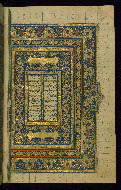
- Title: Double-page illuminated frontispiece
- Form: Frontispiece
- Label: This is the right side of a double-page illuminated frontispiece that precedes the beginning of the main text of the Shāhnāmah (Book of kings).
fol. 9a:
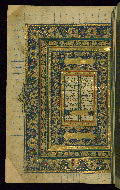
- Title: Double-page illuminated frontispiece
- Form: Frontispiece
- Label: This is the left side of a double-page illuminated frontispiece that precedes the beginning of the main text of the Shāhnāmah (Book of kings).
fol. 12a:
fol. 13b:
fol. 15a:
fol. 23a:
fol. 26b:
fol. 30b:
fol. 32a:
fol. 36a:
fol. 38a:
fol. 41b:
fol. 55b:
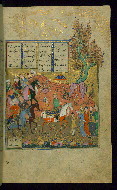
- Title: Sām receives Sindukht as envoy from the king of Kābul
- Form: Illustration
- Label: There is a later inscription on this illustration bearing the name of the painter Rizā with the date 1070 AH / 1659-60 CE.
fol. 62b:
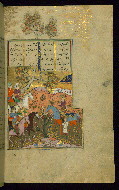
- Title: Qubād discusses death before fighting Bārmān
- Form: Illustration
- Label: Illegible signatures are present, as well as the spurious date 1082 AH /1671 CE.
fol. 69a:
fol. 75a:
fol. 76b:
fol. 79b:
fol. 82b:
fol. 102b:
fol. 105b:
fol. 106b:
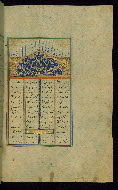
- Title: Incipit page with illuminated headpiece
- Form: Incipit; headpiece
- Label: This incipit page with illuminated headpiece introduces the story of Siyāvush.
fol. 113b:
fol. 125a:
fol. 128b:
fol. 138b:
fol. 147a:
fol. 158b:
fol. 163a:
fol. 168b:
fol. 176a:
fol. 196a:
fol. 204a:
fol. 207a:
fol. 216a:
fol. 224b:
fol. 228a:
fol. 235b:
fol. 241a:
fol. 246b:
fol. 247b:
fol. 251a:
fol. 263a:
fol. 264b:
fol. 274a:
fol. 278b:
fol. 279b:
fol. 280b:
fol. 281b:
fol. 282b:
fol. 284a:
fol. 289a:
fol. 290b:
fol. 302a:
fol. 311a:
fol. 314b:
fol. 319a:
fol. 325a:
fol. 335b:
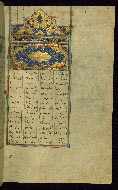
- Title: Incipit page with illuminated headpiece
- Form: Incipit; headpiece
- Label: This incipit page with illuminated headpiece introduces part 2 of the Shāhnāmah, beginning with the story of King Luhrāsp.
fol. 337b:
fol. 341b:
fol. 346a:
fol. 355a:
fol. 377b:
fol. 381a:
fol. 391b:
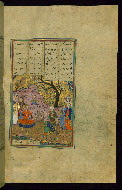
- Title: Rustam and Isfandiyār parley
- Form: Illustration
- Label: This illustration is a spurious later attribution to Shaykh ʿAbbāsī with the date 1097 AH / 1685 CE.
fol. 397b:
fol. 403a:
fol. 410b:
fol. 415b:
fol. 423b:
fol. 427a:
fol. 433b:
fol. 456b:
fol. 460b:
fol. 462b:
fol. 465a:
fol. 472b:
fol. 476b:
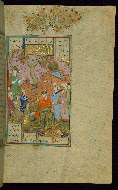
- Title: Bahrām Bahrāmiyān enthroned
- Form: Illustration
- Label: This illustration is a spurious later attribution to Shaykh ʿAbbāsī with the date 1097 AH / 1685 CE.
fol. 479b:
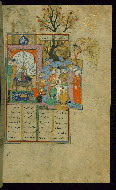
- Title: The infant king Shāpūr II enthroned
- Form: Illustration
- Label: This illustration is a spurious later attribution to Riz̤ā ʿAbbāsī with the date 1097 AH / 1685 CE.
fol. 486a:
fol. 488a:
fol. 493a:
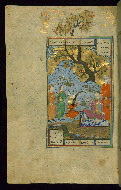
- Title: Munzir introduces Bahrām Gūr to two maidens, one a servant, the other a harpist
- Form: Illustration
fol. 494b:
fol. 499b:
fol. 504a:
fol. 513a:
The binding is not original.
Dates to the thirteenth century AH / nineteenth CE; Qajar-style lacquer boards (no flap); central ovals and pendants decorated with animal scenes; doublures with dentelle-style filigree work
Walters Art Museum, 1931, by Henry Walters bequest
Richard, Francis. Catalogue des manuscrits persans. (Paris: Bibliothèque nationale, 1989), no. 278.
Storey, C. A. Persian Literature: A Bio-Bibliographical Survey, Vol. 1. (London: Luzac, 1927- ), 112-159.
Schmitz, Barbara. “Miniature Painting in Harāt, 1570-1640.” (PhD diss., New York University, 1981), 353-358.
Principal cataloger: Gacek, Adam
Catalogers: Landau, Amy; Smith, Sita
Editor: Bockrath, Diane
Conservators: Jewell, Stephanie; Quandt, Abigail
Contributors: Barrera, Christina; Emery, Doug; Herbert, Lynley; Noel, William; Simpson, Shreve; Tabritha, Ariel; Toth, Michael B.; Valle, Chiara
The Walters Art Museum
Licensed for use under Creative Commons Attribution-NonCommercial-ShareAlike 3.0 Unported Access Rights, http://creativecommons.org/licenses/by-nc-sa/3.0/legalcode. It is requested that copies of any published articles based on the information in this data set be sent to the curator of manuscripts, The Walters Art Museum, 600 North Charles Street, Baltimore MD 21201.
